
As we all know, one of the core elements of feeding and management is temperature, which is interdependent and restrictive with humidity and ventilation. If the three are not coordinated well, temperature differences will occur.
Temperature difference seems simple to say, but it is not easy to effectively control the entire breeding process. Temperature differences usually have the following situations.

1. Seasonal temperature difference
It mainly refers to the four seasons throughout the year, the impact of the seasons on feeding and management, and the changes in feeding and management caused by the easy mutation of climate when the seasons change.
2. Weather temperature difference
It mainly refers to the changes and responses to feeding management caused by weather conditions such as clear, cloudy, fog, rain, frost, snow, and wind.
In the breeding process, only by constantly changing with the changes in the environment can the chickens minimize the incidence of disease. Therefore, chickens like to be diligent and avoid laziness.
On sunny days, you should pay attention to the temperature that changes with time, and adjust the ventilation volume at any time. If the winter is hot and cold, try to extend the boiler heating time to ensure good ventilation.
Effective ventilation must be ensured on foggy days. Some farmers often close windows or ventilation ducts on foggy days for fear of fog entering the chicken house. This approach is wrong because the low pressure in foggy weather is not conducive to the diffusion of pollutants. At this time, Closing the air inlet will only make the chicken house stuffy, resulting in reduced ventilation in the house, and the air quality cannot be guaranteed.
When there is frost, it is often hot during the day and cold at night, especially between 1 and 5 in the morning. Pay attention to the few air inlets, reasonable negative pressure, and normal operation of the furnace.
If it snows and does not turn cold, it is necessary to clear the snow on the roof in time, increase the temperature of the house appropriately, and ventilate carefully, especially when the snow melts.
The most important consideration for the impact of sudden changes in weather and large temperature differences on breeding is speed and timeliness. Don’t think that it doesn’t matter if it’s cold for a while, or it doesn’t matter if it’s hot. You must know the details that determine success or failure, understand weather changes in advance, and take countermeasures.

3. Temperature difference outside the house
The temperature difference is formed by the temperature inside the house and the temperature outside the house, so understanding the temperature difference between the inside and outside the house is a very important reference indicator for the ventilation opening switch and the negative pressure.
4. Heat source temperature difference
To solve this problem, we can increase the amount of air entering the high-temperature area to make the hot air flow to the low-temperature area, and the air inlet in the low-temperature area can be appropriately reduced or closed.
The heat sinks or air supply bags used in the heater should be installed on both sides of the wall as much as possible, and the air should be blown to the wall. This has the advantage of reducing and buffering the cold air from the outside and avoiding local low temperatures that may cause the chickens to catch cold.
The main reason is that the overall temperature of the chickens around the heat source of the chicken house is different from that of chickens slightly farther away from the heat source. Special attention should be paid to this point, especially for chickens heated by warm air stoves.
5. Temperature difference at the entrance to the chicken house
Generally, the wind that comes in instantly from the air inlet is cooler and is easiest to ignore. Therefore, more than 70% of the respiratory tract of chickens is caused by the inlet temperature difference.
When there is a temperature difference of more than 10 degrees between the temperature outside the house and the temperature inside the house, the temperature inside the chicken house may not be low, but if the temperature difference is too large, the temperature difference has already changed dramatically. Therefore, plastic paper should be used at the entrance of the chicken house. Prevent personnel from entering the chicken house and taking advantage of the cool breeze to blow in. The wind will directly hit the chickens and cause them to become cold.
6. Expand group temperature difference
It refers to the 15% respiratory tract temperature difference produced before and after the expansion of the chicken flock, which is related to the large temperature difference between the front and rear ends of the flock expansion.
When is the appropriate time to expand the flock? When the temperature is sufficient, the smaller the density of the flock, the better. However, the biggest burden is that no matter when and under what circumstances, there should be no chickens behind, whether eating food or drinking water. Waiting, or squeezing in food and water.

Notes on group expansion:
1. Before expanding the colony, appropriately increase the temperature inside the house by 0-5 degrees and continue until the colony is expanded for more than 24 hours, then gradually drop to the normal temperature.
2. Before expanding the flock, incubate the location to be expanded to a temperature not lower than the existing temperature in the chicken house. When the temperature is sufficient, pull down the plastic partition first and expand the flock after 3 hours.
3. When expanding the flock, try to choose a time when the weather is sunny. Do not expand the flock one day before and after vaccination. When the chickens are sub-healthy, expand the flock carefully.
4. Broiler moulting period: The temperature difference during the moulting period should not exceed 2 degrees, so the daily temperature drop should not be too large. If the temperature difference changes significantly, it will cause disease in the chickens, resulting in a large investment in medicines and breeding. fail.
People often say that the temperature has not changed, the ventilation has not changed, and the chickens have caught a cold again. If the wind blows, the chickens will get the flu again. What is the reason? The humidity inside the house has changed dramatically, for example, the humidity dropped from 60 to 20-30, and the body temperature has changed by 2-3 degrees (it is precisely the link that everyone pays less attention to that has caused fatal problems)
In short, there are many reasons for the disease in chickens. Low antibodies in the chickens, coupled with management errors, especially large temperature fluctuations in the small environment inside the house, will cause the disease in the chickens.
On the contrary, only when the temperature difference in the small environment of the house changes little, the humidity is suitable and stable, and the ventilation transition is reasonable can the incidence rate be reduced, or the loss after the onset of the disease be small.
The POULTECH IoT platform can view chicken house environmental information on mobile phones and computers at any time. No more worries about your chickens getting sick.
Contact POUL TECH
Email: duncan@cnpoultech.com